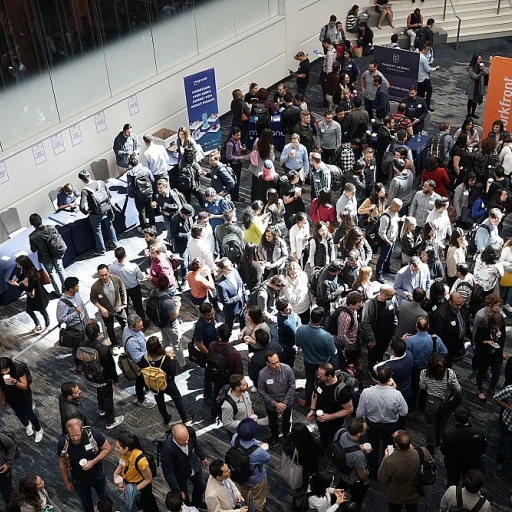Why Employee Retention Matters More Than Ever
The Importance of Holding onto Your Workforce
In today's fast-paced business environment, ensuring that your team remains motivated and committed is no longer just a nice-to-have—it's a business imperative. Employee retention is more critical than ever, as high turnover rates can significantly impact an organization's bottom line and reputation. With competition for talent growing fiercer, companies need to prioritize
boosting employee happiness and loyalty to succeed.
The Cost of Turnover
One of the most tangible impacts of employee turnover is the direct cost associated with replacing employees. Recruiting, hiring, and training new staff involves substantial expenses, not to mention the time and resources diverted from other business operations. Additionally, the loss of institutional knowledge and the possible decline in team morale can further derail productivity.
Benefits of a Stable Team
A stable and engaged workforce contributes to a positive organizational culture, fostering innovation and collaboration. Employees who feel valued and see a clear path for advancement are more likely to invest their energy and ideas into the company's success, reducing the risk of attrition and creating a thriving work environment.
As you consider developing a comprehensive approach to employee retention, keep in mind the pivotal role that company culture and flexible work arrangements will play (as explored further in future discussions). Tracking your organization's employee retention rates can offer valuable insights and help refine your strategy over time. By prioritizing the retention of your talented team, you're not just averting potential pitfalls—you're also laying the groundwork for sustained growth and excellence.
Understanding Why Employees Leave
Examining the Reasons Behind Employee Departures
Understanding the motivations behind why employees choose to leave their roles can provide valuable insights into creating a more effective retention strategy. Employees often depart for a variety of reasons, ranging from the pursuit of better compensation and advancement opportunities to dissatisfaction with management or company culture.
A critical factor often contributing to employee turnover is the lack of growth and advancement opportunities. Employees desire not only to feel valued but also to see a clear path for their development within the organization. When businesses fail to provide this, employees are likely to seek it elsewhere.
Another significant element leading to departures is the lack of support and engagement from management. Employees who feel neglected or undervalued by their supervisors are less likely to remain loyal to the company. Effective leadership can often be the key to preventing this. By fostering open communication and showing genuine appreciation for employees’ efforts, management can build a more engaged and committed team.
Work-life balance is another crucial factor that cannot be overlooked. When employees feel overworked or unable to balance their professional and personal lives, they may begin to look for companies that prioritize flexible working arrangements.
Lastly, company culture plays a significant role in retention. A culture that aligns with employees’ values and provides a sense of belonging tends to enhance job satisfaction and reduce turnover rates. A strong, positive company culture offers a supportive environment where employees are empowered and motivated.
For more insights on how to boost employee loyalty and engagement, consider reading about
boosting employee happiness and loyalty.
Crafting a Retention Strategy That Works
Building an Effective Retention Plan
Crafting a strategy to retain your employees involves more than just a competitive salary. As mentioned earlier, understanding why employees leave is crucial to creating a solid plan. Once you've identified these reasons, it's time to address them head-on with targeted solutions.
Start by evaluating your organization's strengths and weaknesses in retaining talent. Do you provide competitive benefits, growth opportunities, and a supportive work environment? If not, these could be areas for improvement. Tailoring your strategy to fit the unique needs of your workforce can significantly reduce turnover rates.
Regular feedback sessions can also play an essential role in retention strategies. Employees want to feel heard and acknowledged. By fostering open communication, you can gain insights into their job satisfaction and areas where they seek improvement or change.
Moreover, as emphasized in other parts of this article, company culture significantly impacts employee happiness and engagement. Cultivating a positive and inclusive culture can go a long way in retaining talent. To learn more about enhancing employee satisfaction, consider exploring ways to
keep your remote employees happy and engaged.
Ultimately, crafting a retention strategy that resonates with your team involves a mix of understanding their motivations, addressing their needs, and offering an environment where they can thrive. With careful planning and execution, you can foster a workplace that not only attracts but also retains invaluable talent.
The Role of Company Culture in Employee Retention
The Power of a Positive Work Environment
One of the most influential factors when it comes to retaining employees is the company culture. A positive work environment not only boosts productivity but also keeps employees engaged and satisfied. When team members feel valued and supported, their likelihood of staying with the company significantly increases.
Company culture goes beyond casual Fridays or office amenities—it's about creating an atmosphere where everyone can thrive. This includes clear communication, recognition for achievements, and a sense of belonging. To achieve this, organizations must be intentional about fostering a culture that aligns with their core values and mission.
Leaders play a critical role in shaping this environment. They should aim to be accessible, encourage open dialogue, and cultivate trust within their teams. By leading by example, managers can inspire their employees to embrace the company's vision and contribute meaningfully to its goals.
To ensure a nurturing atmosphere, companies should also prioritize professional development and career progression opportunities. By investing in employee growth, organizations demonstrate their commitment to their staff's long-term success, reinforcing their loyalty and reducing turnover rates.
In conclusion, focusing on creating a supportive and positive company culture can dramatically improve employee retention. It's essential for businesses to consistently evaluate and refine their workplace environment to keep their teams motivated and invested in the company's future.
Flexible Work Arrangements: A Game Changer
The Impact of Flexible Work on Staff Commitment
In today's ever-evolving workplace, maintaining a happy and engaged team often involves thinking outside the box, and one notable approach has been the implementation of flexible work arrangements. The traditional 9-to-5 grind is no longer appealing or feasible for everyone, and offering flexibility can be a game-changing management move.
Flexible work arrangements refer to setups that allow employees to choose when, where, and how they work. This could include options like remote work, flexible start and finish times, compressed work weeks, or a results-oriented work environment. The key to successfully implementing these strategies is to ensure alignment with both company goals and employee needs.
Enhancing Job Satisfaction
Flexible work arrangements can significantly enhance job satisfaction, a critical component of employee retention. By giving employees the autonomy to balance work demands alongside personal commitments, organizations can foster a strong sense of trust and respect. This, in turn, boosts morale and job fulfillment. Employees who feel they have control over their working conditions are often more productive and loyal, which is crucial to retaining top talent.
Addressing Diverse Workforce Needs
With a diverse workforce comes varying needs and expectations. Flexible work arrangements cater to these differences, allowing personalized work experiences that can effectively reduce employee turnover. As discussed in earlier sections, understanding why employees leave is pivotal. Not everyone thrives under a rigid schedule, and considering different work styles can be a proactive measure to meet diverse workforce requirements.
Implementing flexible work solutions involves open communication and trust between employers and employees. It's about creating a supportive framework where individuals can thrive, ultimately contributing to enhanced productivity and innovation. Employers who value employee well-being by offering flexible arrangements will likely see a workforce that's not only retained but also thriving.
Measuring Success: Tracking Employee Retention Rates
Mastering the Art of Measuring Employee Retention Success
In the journey to bolster employee retention, it is crucial to know whether your strategies are hitting the mark. Measuring success in retaining employees is more than just keeping tabs on who stays—it’s about understanding why they stay and how your initiatives impact overall satisfaction and engagement.
To effectively measure employee retention, consider starting with a comprehensive analysis of your workforce turnover rates. This involves calculating the percentage of employees leaving within a given period and identifying any patterns or trends that emerge. Such data will give you a clear indicator of how your retention efforts have evolved over time.
Beyond tracking turnover, delve deeper into employee satisfaction and engagement metrics. Regular pulse surveys are a valuable tool to gauge how your workforce feels about various aspects of their work environment, from company culture to flexibility. Meaningful responses can illuminate areas for improvement and directly impact your retention strategy. Refer back to our insights on crafting a strategy that is both effective and aligned with your organization's values.
Another essential metric is the length of employment. By examining the tenure of employees, you can discern if recent strategies (such as those regarding flexible work arrangements) are resonating with your team. It pays to remember that successful retention is not just about length of stay, but about fostering a productive and positive atmosphere that encourages employees to remain invested in their roles.
Finally, feedback from exit interviews is a goldmine of information. While it may seem like too little, too late, the insights gained from understanding why employees choose to leave can shape future retention policies. It profoundly connects with understanding employees’ reasons for leaving, as we explored in earlier discussions.
By maintaining a structured approach to evaluating these metrics, businesses can not only track their progress but also continually refine their employee retention strategies, ensuring a happier, more engaged workforce.








